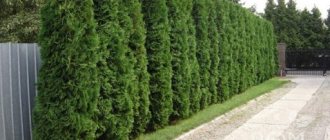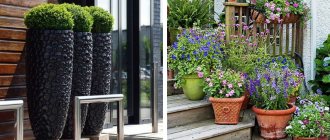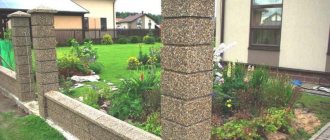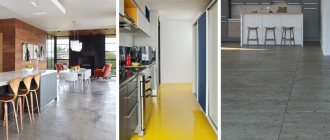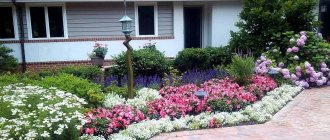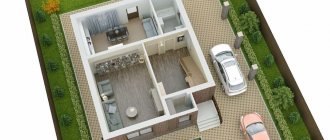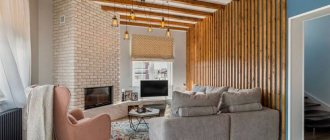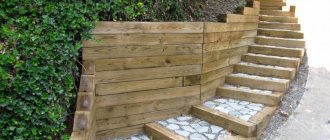From the beginning of December we begin the countdown to the New Year. We begin to slowly decorate our homes and plan what we will do during the holidays.
The interiors are gradually saturated with the smells of tangerines, ginger and spices.
If you have a country house, then you will have to devote a lot of time and effort to decorating the site. It is worth noting that the desire to have a beautiful tree that can be decorated for the New Year is one of the most common among owners of dachas and mansions. The topic does not lose its relevance year after year, so we will discuss what types of trees you should pay attention to, focusing on your wishes and the capabilities of the site.
So, the prickly spruce (Picea pungens) is recognized as the queen of the winter garden - this plant can be found on every gardener’s list. If you haven’t heard this term, then you probably know the blue spruce for sure. One of the advantages of these spruce trees is that, unlike common spruce, they are practically not susceptible to disease. Prickly spruce tolerates transplantation well.
Source: lovely-dom.ru
The main mistake when choosing a particular spruce is that most people do not take into account the capabilities and characteristics of the tree - growth, crown structure, density. That is why you should decide how to choose the appropriate variety of spruce for your site.
Spruce Glauca
Source: ld7.ru
This variety is the most popular, and its affordable price plays a significant role. This is what causes most errors. The faster a tree grows, the cheaper it costs! You buy a small one, and you get a spruce up to 15-20 meters in height, which reaches 6-8 meters in width. Conclusion : such a spruce is suitable only for a large area. Also, you should not place large trees near it.
Flaws
The main disadvantages, based on the experience and reviews of experienced gardeners, are the following:
- Low resistance to fungal diseases, the need to use fungicides.
- Risk of damage to branches and crown as a whole.
- Short lifespan of some varieties.
- Problematic propagation by cuttings.
- The possibility of burning of young needles when exposed to direct sunlight during peak hours in the spring and summer.
Spruce BlueDiamond
Source: altai-zabor.ru
A pretty tree showing off the rich colors of the needles. Reaches 5-6 meters in height. The shape of the crown is wide and very dense, so this variety is quite worthy of claiming the main role of the New Year spruce. In nurseries you can most often find small specimens; a tree taller than 1-1.5 m will have to be looked for, and the price will be high. Conclusion : a good variety for small gardens, it is worth the time to find a decent tree.
Types of fir trees
The genus Spruce (Picea) includes up to 45 species, which naturally grow in cold and temperate climates, on sandy and rocky soils, and less often in wetlands. The center of origin is considered to be the harsh mountainous terrain of China. The plants are quite unpretentious, drought-resistant, most tolerate the harshest winters without loss, some species are quite tolerant of excessive soil moisture and air pollution.
As soon as you decide on the type and variety of spruce, we recommend reading our article “Spruce - planting and care,” it will help you grow an excellent spruce tree from a spruce seedling.
Norway spruce (Picea abies)
A large tree, growing up to 50 m in height, characterized by a pyramidal crown with a pointed apex. The branches are directed to the sides or obliquely downwards, raised at the ends. The needles are juicy green, glossy, tetrahedral in shape, up to 2.5 cm long. The cones are oblong, greenish or purple when immature. The hardy local species is widespread in the European part up to the Urals, and usually does not cause problems in acquisition and care.
Acrocona
Norway spruce variety Acrocona
A bright, slow-growing variety that appeared at the end of the 19th century in Finland. The crown forms a wide pyramid, is located low, reaches a height of 4 m, with a diameter of 2.5–3 m. The young plant is compact, round in shape. The difference between Akrokona is early, abundant and very colorful fruiting; immature lilac-crimson cones appear in abundance at the ends of skeletal branches and wonderfully decorate the plant.
The needles are dark green in tone, with delicate hanging young growths of a herbaceous hue, which makes a striking contrast. An excellent choice for landscaping small gardens and solitary plantings on the lawn.
Ohlendorffii
Norway spruce variety Ohlendorffii
Dwarf spruce with a compact crown comes from Germany. By the age of ten it reaches 1–2 m, develops slowly, and grows 3–6 cm annually. The crown is wide, first round, then pyramidal in shape, multi-peaked. The branches are dense, spread to the sides and raised at the ends, densely covered with fine green needles, sometimes with a golden tint. The variety is shade-tolerant, unpretentious, suitable for creating mixborders or decorating rocky hills.
Frohburg
Norway spruce variety Frohburg
Swiss original weeping spruce with a straight, slender trunk. The plant is medium-sized; by the age of ten it can grow up to 2–4 m. The branches are sloping, fall to the ground, and spread with age, forming a kind of lush trail, which looks unusual and attractive.
The needles are light green in color, short and stiff. Immature cones are greenish-crimson, growths are emerald green, oblong-round in shape. A stunning variety for solitary plantings, it gives compositions an elegant vertical accent and is of interest to lovers of unusual ornamental plants.
Serbian spruce (Picea omorika)
A tall tree with a narrowed conical or columnar shape with a pointed top. The needles are flattened, glossy, dark green in color, marked on the reverse side with two silvery-white lines. The cones are small, bluish-black in color.
This beautiful, stable species is unpretentious to soils, tolerates air pollution well, and under natural conditions is distributed in the mountainous areas of the Balkan Peninsula.
Nana
Serbian spruce variety Nana
The dwarf variety is characterized by a dense, rounded crown in young specimens, then the crown becomes broadly conical with a pronounced pointed tip. The height of an adult plant is no more than 3.5 m and a width of about 2 m; it develops at a pace that is moderate for low-growing varieties; by the age of ten it reaches one and a half meters.
The main branches are directed obliquely upward, covered with radially directed glossy needles of emerald color with a distinct bluish tint and light stripes on the underside. Planted in oriental gardens, thanks to its spectacular blue tint and compactness, it is successfully used to create contrasting woody compositions.
Peve Tijn
Serbian spruce variety Peve Tijn
The undersized sport of the previous variety was selected by Dutch breeders. The cone-shaped wide crown is very dense, with a smooth, dense surface. It grows by 5–6 cm per year, reaching just over one and a half meters in height by the age of ten. The needles are golden-green with a blue or silver tint. The attractive color combination is especially pronounced on annual growths and in plants planted in open sunny areas.
Canadian or gray spruce (Picea glauca)
A powerful tree reaches a height of 25–30 m; in cultivation it grows moderately – no higher than 10–15 m; in nature it is widespread in the forests of North America. The crown is dense, the main branches of young plants are raised, and those of adults are directed downwards. The needles are thick, bluish-green. The cones are small, light green, turning brown when ripe.
Alberta Globe
Canadian spruce variety Alberta Globe
The miniature, round-shaped plant becomes dome-shaped in maturity. By the age of ten, the diameter of the dense crown is about 30 cm, with annual growth of 2–3 cm; over the years, the lush conifer grows in width up to 0.7 m and reaches 1 m in height.
The needles are light green, elegant, densely covering the dense side branches, forming a bumpy continuous surface. A wonderful variety for planting in rockeries or flower beds, it looks good in homogeneous groups.
Conica
Canadian spruce variety Konica (Conica)
A slow-growing variety of Canadian selection, it is distinguished by a dense conical crown of regular shape. In adulthood, it grows no higher than 2 m with a width at the base of about one and a half meters. The surface is smooth, dense, the branches are directed upward. Spiny elastic needles of juicy green color are located radially.
Konica does not require formative pruning and is wonderful for arranging mixborders, decorating rocky hills and growing in containers. The plant is resistant, prefers sparse partial shade, growths are susceptible to spring burns.
Sanders Blue
Canadian spruce variety Sanders Blue
The famous blue variety is one of the best in its color group. It develops slowly, growing 4–5 cm per year. By the age of ten it reaches 0.7 m in height and 1.3–1.5 m in diameter. The crown is conical, regular, and becomes loose in the shade.
The needles are bright, fresh silver-blue in color, on young growths they are more saturated in color, on old branches they are bluish-green, which is why the surface appears unevenly colored, which is especially noticeable on specimens growing in the shade. Sometimes reversions may appear - completely green branches, which are carefully cut out from the trunk in early spring so as not to spoil the overall impression.
Engelmann spruce or weeping spruce (Picea engelmanii)
Slender conifers up to 50 m high naturally grow on the poor soils of the Rocky Mountains of North America. The crown is cone-shaped, wide, with sloping branches covered with sharp bluish-green needles on the growths, darkening at the base of the branches. The cones are small, oblong-conical, up to 7 cm long, burgundy in color when ripe.
Bush's Lace
Engelmann spruce variety Bush's Lace
A beautiful unusual variety with a straight trunk and a pyramidal loose crown. The young plant actively produces growth - 20–30 cm per year, growing up to 7 m in height and about 1.8 m in diameter. The skeletal branches are raised at the base, drooping at the ends, the lower branches lie on the ground, forming a lush trail.
The main color is bluish-green, the spectacular large growths are bright, contrasting, silver-blue. It looks best solitary in open areas; in the shade it loses its richness of color and attractive shape, growing unevenly.
Snake
Engelmann spruce variety Snake
A tall tree with a sparse crown and bluish-green needles, silvery on growths. The skeletal branches are practically without lateral branching, characterized by growth from the apex, horizontally directed, spread out, slightly raised at the ends. The variety is rare, mainly grown by exotic lovers, excellent as a tapeworm, adding sophistication to oriental and rocky gardens.
Prickly or blue spruce (Picea pungens)
A common cultivated species, beautiful and frost-resistant, tolerates air pollution well. Distributed in the mountainous areas of North America, grows up to 30–40 m in height, characterized by a dense, wide-pyramidal crown, evenly developed. The skeletal branches are directed horizontally, spread out and raised at the ends.
Young shoots are bright brown, bare. The needles are gray, becoming increasingly green with age. The advantage of the species is its tolerance to excess moisture and the ability to develop well in low-lying areas.
Hermann Naue
Prickly spruce variety Hermann Naue
A dwarf, spectacular, cushion-shaped variety, without a pronounced central stem, with numerous lateral branches directed in different directions. By the age of ten, the compact plant reaches half a meter in height and up to 0.7 m in diameter. The needles are bluish-gray, bright. Numerous oblong cones of light brown color appear in abundance at the ends of the shoots at an early age and serve as a wonderful decoration.
The Blues
Prickly spruce variety The Blues
A stunning blue sport of the Glauca Pendula variety. The plant is medium-sized - no higher than 2.5 m and up to 1 m in diameter, with a straight stem and drooping top. The branches are horizontally spread, the ends are directed downwards. The needles are long, silver-blue in color, as if covered with frost, the growths are bright blue. Successfully grafted onto a standard.
Hoopsii
Prickly spruce variety Hoopsii
The classic form of gray spruce was developed in the USA in 1958. The lush beauty does not require a huge plot, growing up to 10–12 m in height and no more than 3–4 m in width at maturity. It develops quickly - 15–20 cm per year, the branches are strong and elastic, and do not break during snowfalls. The crown is harmonious, pyramidal, with outstretched, densely packed skeletal branches and multiple lateral branches, diversified.
The needles are large, up to 2.5 cm long, rich blue in color; the growths are light blue. Small purple cones provide an additional color accent. Looks great in single plantings and alleys, as well as in multi-colored compositions of conifers.
Black spruce (Picea mariana)
A large tree with a narrow pyramidal crown, in natural conditions it grows up to 20–30 m, in cultivation by the age of ten it is no higher than 3 m. The needles are short, bluish-green, and dense. The branches are brick-brown, covered with reddish pubescence. The winter-hardy, unpretentious species does not have a huge selection diversity, numbering only 6–7 varieties.
Nana
Black spruce variety Nana
The dwarf plant is characterized by a dense, rounded-flattened crown with a smooth surface. The main branches are horizontally directed, completely covered with lateral branches directed in different directions. It develops slowly, growing 3–5 cm per year. In adulthood, it reaches no more than half a meter in height and about 1 m in diameter.
The needles are short, bluish-green, on the shoots of the current year they have a spectacular bright green color, contrasting. An unassuming compact variety will serve as a wonderful element of a flower garden and rock garden; it grows well in container culture.
Aurea
Black spruce variety Aurea
A slow-growing tree of a pyramidal shape by the age of ten grows no higher than 1.5–2 m, then growth accelerates, and an adult plant reaches 5–7 m. The branches are outstretched, drooping at the ends, densely covered with short bluish-green needles with cream tips. The growths are much lighter, golden yellow. The elegant conifer looks great both in colorful, diverse compositions and as a solitaire.
Siberian spruce (Picea obovata)
A slender spruce with a narrow cone-shaped crown growing low to the ground is considered one of the most resilient species. Growing shoots are light brown in color, with slight pubescence. The glossy needles are sharp, up to 3 cm long, dark green in color. The species is in many ways similar to Norway spruce, but develops more slowly, reaching a height of no more than 35 m. It is distributed in the forests and mountainous areas of Siberia, China, Mongolia and northern Europe.
Glauka (Var. glauca)
Siberian spruce variety Glauka (Var. glauca)
The medium-sized variation with a pyramidal crown 10–12 m high grows intensively – 20–25 cm per year. The skeletal branches are widely spread, directed obliquely upward, the central stem is smooth and clearly defined. The needles are elastic, linear-needle-shaped, tetrahedral, silver-blue, very impressive. Glauka is highly frost-resistant, unpretentious and quite shade-tolerant. Used as a tapeworm, for group plantings and alleys.
Eastern spruce (Picea orientalis)
A common species grows in the mountainous areas of the Caucasus and northern Turkey. The tree is large, up to 60 m in height. The dense pyramidal crown is symmetrically developed, with branches raised at the base and sloping at the ends. It grows up to 20 cm per year, young trees develop much more slowly.
The needles are short, hard, thick green in color. The cones are a striking reddish-purple hue, oblong, narrowed in shape, 6–8 cm in size. Spruce prefers light soils, does not develop well on heavy soils, and freezes slightly in harsh, dry winters.
Nutans
Oriental spruce variety Nutans
A beautiful tree in the shape of an uneven pyramid, formed by unevenly growing branches, horizontally spread and raised at the ends. The side branches hang down. At first it grows moderately, in adulthood it grows more intensively, growing 20–30 cm per year. Mature trees can reach 18–20 m in height, with a diameter of 7–9 m.
The needles are needle-like, very thick and short, about 1 cm long, dark green, glossy. Young shoots are bright green in color. Immature cones are showy, reddish-purple, mature ones are brown. A fairly large conifer requires sufficient space; it is usually grown in a single planting.
Aureospicata
Eastern spruce variety Aureospicata
The magnificent oriental spruce was obtained by German breeders at the end of the 19th century. A medium-sized tree in maturity reaches 10–15 m, characterized by a wide pyramidal crown, slightly loose. The drooping branches are located unevenly, raised at the ends, the side branches hang beautifully.
The needles are thin, very short, dark green. The greenish-yellow bright growths, as well as small crimson-colored cones, make the conifer especially attractive. The elegant tree is rightfully considered one of the best representatives of the species.
Spruce mariorika (Picea x mariorika)
Obtained by crossing black and Serbian spruce in Germany at the beginning of the 20th century; later, a few but very interesting varieties were bred. It is a large plant up to 30 m high, with a wide pyramidal crown. The branches are horizontally directed, covered with flat bluish-green needles, with distinctive silver stripes on the underside. The cones are small - up to 5 cm long, purple in color when immature.
Machala
Spruce mariorica variety Machala
Czech dwarf variety, up to half a meter high and about 1 m wide, cushion-shaped. The branches are diversified, horizontal, dense, raised from the base. The spiny needles are up to 1.5 cm long, silver-blue in color, lighter on the inside. The origin remains the subject of heated debate - various sources claim that the interesting variety was obtained not from Serbian spruce, but from Iez or, according to another version, Sitka.
Iezskaya or Ayanskaya spruce (Picea jezoensis)
A wonderful coniferous tree, in nature reaching 30–50 m in height, in cultivation by the age of thirty it grows no higher than 8–10 m. Under natural conditions, the species is common in the Far East and the Korean Peninsula, China and Japan, is considered extremely winter-hardy, grows near rivers , loves sprinkling of the crown, shade-tolerant.
The crown is pyramidal, the skeletal branches are directed obliquely upward. Flat needles up to 1.5–2 cm long, blunt or with a small point, dark green, with bluish-white stripes below, last up to 10 years. The needles fit tightly to the branches; in good lighting they tend to puff up, which gives the plant a light silvery tone. The cones are oval-oblong, up to 8 cm long, in an immature state, purple-crimson or light green.
Nana Kalous
Iez or Ayan spruce variety Nana Kalous
A dwarf, squat plant without a pronounced central conductor, round, about 1 m in diameter. The skeletal branches are evenly spaced, directed horizontally and obliquely upward, the lateral branches are short and grow in abundance. The tousled needles with a bluish underside are bright and attractive. Very nice shape, looks good on alpine slides, in the foreground of mixborders.
Spruce Montgomery
Source: florrina.com
A dwarf variety up to 1-1.5 meters in height and the same in width, it grows very slowly. Its analogue is Glauca Globosa.
Source: hoga.ru
Conclusion : a suitable solution for small gardens.
Would you like a Christmas tree in your garden? This is an excellent solution for those who do not like artificial trees, but are also against deforestation. With coming! Celebrate the New Year in beauty and harmony!
Source: idolza.com
HOW TO GROW DECORATIVE SPRUCE
All decorative spruce trees are characterized by increased frost resistance and drought resistance. They are very unpretentious, undemanding to weather anomalies and resistant to conifer diseases.
You need to choose a sunny place for small decorative Christmas trees, otherwise their bright needles will fade and lose their attractiveness.
Ornamental spruce trees need soil that is fertile, rich in organic matter, very loose, moist and moderately acidic (pH 5.3 - 5.7).
Planting holes are made 70 cm deep and 60 cm in diameter. They are well filled with rotted manure, humus, sand and fertile soil (in equal quantities), adding phosphorus-potassium fertilizers. At the bottom of the pits, drainage made of broken bricks or gravel must be laid in a layer of 20 cm.
When planting several plants, leave 3.5 meters between them. It is very important that after planting the root collar remains at ground level, otherwise it may begin to rot.
Tree trunk circles are mulched with pine needles or sawdust soaked in a urea solution.
Care for decorative spruce trees is minimal. In the spring, two buckets of compost or humus are added to the tree trunk circles; in the fall, a bucket of any peat mixture with the addition of potassium-phosphorus fertilizers is added.
In the first two years after planting, young Christmas trees are watered two to three times a month. In hot weather, spray all the needles with water. For mature trees, one deep watering per month is sufficient.
The crown of spruce trees, like most slow-growing coniferous crops, is not formed. If necessary, sanitary pruning is done in the spring. ( we wrote about this in the article “Which juniper to plant on a personal plot” )
Tips from Petrovna: which coniferous trees to choose and where to plant them
Hello, my dear! Not long ago, at one of the garden exhibitions, I unwittingly overheard a dialogue between two lovely ladies. “Look, what a wonderful Christmas tree!” – one of them clasped her hands. “This is not a Christmas tree, but a pine tree,” said the second one with conviction. Of course, I couldn’t resist being curious: the coniferous plant they liked turned out to be Canadian hemlock (Tsuga canadensis). It seems like a minor problem: gardeners are simply not familiar with this species, which is not yet very common among us. However, if they unknowingly plant it in unsuitable conditions, the hemlock will inevitably die.
Communicating with familiar summer residents, I have long noticed that many are extremely imprudent in purchasing conifers for their plots. I liked it and bought it, without thinking at all that each species (and often variety) needs certain conditions, without which the plant will develop poorly and possibly die.
Of course, more than one encyclopedia has been written about conifers. They discuss in detail the agricultural technology corresponding to each type, including a lot of details related to the characteristics of individual varieties. But, be honest, my dears, have any of you mastered these fundamental works? Can you, standing near the counter and looking at a pretty Christmas tree, remember what was written about it, for example, on page 327? That is why it is worth remembering a few simple rules that will help you quickly navigate at the right time. I was convinced of this from my own experience.
Pines
Let's start with the pine trees. There are about 100 species, but the most commonly found varieties on sale are Scots pine (Pinus sylvestris), mountain pine (P. mugo) and Weymouth pine (P. strobus). Most of them need good lighting. If you have a heavily shaded area, then it is better to avoid purchasing these plants. True, s. Weymouth also tolerates partial shade. Moreover, some varieties with variegated needles are not recommended to be planted in the sun to avoid burns. But in general - “let there always be sunshine”! As for the soil, even poor ones will do. The main thing is that it is dry: pine trees will not grow in swampy areas and in places with close groundwater.
Let's move on now to the spruce trees. They have half as many species as pine trees - “only” about 50. And even less are sold here! These are common spruce (Picea abies), prickly spruce (P. pungens), Serbian spruce (P. omorica) and Canadian or gray spruce (P. glauca), or rather, their numerous varieties. For the most part, they prefer not to fry in the sun. Moreover, at a young age they can even get burned if you plant them in an open place - just like kids on the beach. This is especially true for Canadian spruce: shade is not just desirable for its varieties - it is necessary. The exception is the prickly spruce: it requires more light. But you are unlikely to confuse it with the others - this is the familiar “blue tree”. Otherwise, the needs of the prickly beauties are similar: they all love moisture. And, first of all, this concerns not the soil, as you probably thought, but air humidity. Spruce trees do not tolerate Wind Blow very well, and they are unlikely to like it in an open field.
Tips for choosing
A wide variety of dwarf plants for the garden are offered by various online trading platforms, gardening and gardening stores, as well as growing nurseries. It is necessary to purchase seedlings from trusted producers.
When choosing samples, be sure to study the seller’s information regarding characteristics and care. A mandatory point when purchasing is the presence of a massive clod of earth, occupying at least 1/3 of the entire seedling in size. Elastic, richly colored needles are considered an indicator of high quality planting material. When transporting, it is better to take burlap for temporary packaging.
Diseases
Dwarf spruce trees can be affected by some diseases and pests. The needles are the first to be affected. The main diseases of dwarf spruce include:
- Tracheomycosis. This is a fungal infection that attacks the roots of the plant. The needles become red and fall off. Most often, young crops suffer from this disease. It cannot be treated. To prevent neighboring bushes from being affected, you need to dig up the diseased plant and burn it.
- Rust. This is another fungal infection. Orange growths appear on the branches. The needles, which have acquired a yellow tint, begin to fall off. Treatment is carried out using Glycodin or Vectra. Spraying is carried out every week for a month.
- Conifer fungus. As the disease develops, the needles acquire a black tint and are also covered with a whitish coating. Afterwards they fall off. To cure the disease, you need to spray with 3% copper sulfate. Later, treatment with Trichodermin and Alirin-B is carried out. If the disease has severely affected the bush, it should be burned.
Particular attention should be paid to pests that can attack small spruce trees. If a bark beetle appears on a tree, you should burn it.
Junipers
As for junipers, in terms of the number of species they are located approximately in the middle between spruces and pines - there are more than 70 of them. But in gardens (and therefore on sale) there are no more than a dozen: Cossack juniper (Juniperus sabina), common juniper (J. communis), scaly (J. squamata), horizontal (J. horizontalis), rock (J. scopulorum), Virginia (J. virginiana) and Chinese (J. chinensis). Still too much? Is it difficult to remember? And you don’t even need to learn this list by heart! Take note that junipers love light. In the shadows they themselves will become a “pale shadow”. Everything except the common juniper: it is no stranger to it, since it is a native inhabitant of the undergrowth, where it gets little sun. The remaining species grow in nature on mountain slopes. As for the soil, junipers are undemanding to it. Although excessively damp areas, of course, are not suitable for them!
Perhaps some of you will not even bother to memorize this brief information: you already have to keep a lot in your head. But I still want to decorate the area with conifers! In this case, I offer you a lifesaver - the western thuja (Thuja occidentalis). Wherever you plant it, it will not disappoint your expectations. In the sun and in the shade, in a humid place or in a dry area - the thuja will adapt everywhere. True, varieties with yellow and variegated needles still require good lighting.
Of course, the list of conifers is not limited to this, but we just started with old acquaintances. The turn will come to firs, larches, and cypress trees.
Oh, yes, I almost forgot about the already mentioned Canadian hemlock! Remember well: this “young lady” is shade-loving. In the most literal sense of the word. This means that under no circumstances should you plant it in an open place: under the hot rays of the sun it will “melt”, like the Snow Maiden from a fairy tale. But in a damp place, under the canopy of large trees, it will show itself in all its glory, delighting everyone who sees it. Just like those lovely ladies at the garden show.
0 0 votes
Article rating
Forest thinning
The next sign by which you can determine the relationship of various species to light is the thinning of the forest
. The faster the forest thins out, the more light-loving the trees are. There is certainly logic here. The sparser the forest, the more light there is.
Trying to create an accurate scale of light-loving and shade-tolerant various breeds, they used different methods, and this is what happened. The most light-loving species of our forests turned out to be. It is followed by birch, then willows, ash, maple
and so on.
The most shade-tolerant were fir, beech, and hornbeam
.
But everything in the world is relative. And the shade tolerance of rocks is not a constant value. Light requirements vary depending on age, soil and climate. Determining the degree of light and shade tolerance of trees is of great importance in forestry; it helps to correctly resolve issues when replacing less valuable species with more valuable ones when growing forests and regulating its density.
Gardening a garden in a shady area is quite an interesting, but difficult task. Bringing the most unusual and exotic ideas to life will require a lot of time and patience. The most important thing is to plan everything correctly and select shade-loving conifers.
The advantage is that shade-tolerant conifers grow well and decorate poorly lit areas of the garden.
Peculiarities:
- coniferous bushes and trees retain their color all year round and always remain green;
- the root system of the plant is well developed and helps obtain the necessary nutrients from the soil with low fertility;
- crown formation is rarely carried out, since in the shade it holds its shape for a long time;
- plants that grow in the shade have a wide variety of colors and shapes;
- shade-loving trees are drought-resistant and are often used in landscape design of garden plots;
- to plant a hedge in the shade, choose several varieties of coniferous plants with different shades to create contrast and enliven the shady area;
- Alpine slides with flowers will look great in areas where the sun rarely hits, in combination with coniferous shade-loving shrubs.
Why don’t conifers take root in the country?
Initially, we want to describe the standard causes of disease in conifers in order to establish why some species do not take root in summer cottages.
Unsuitable climate for conifers
Perhaps you want to grow a plant in your dacha that prefers a frosty and dry climate, and your dacha is located in a region where the climate is different. It is quite possible that, on the contrary, the plant prefers humidity and sun, while your dacha is quite cold and drier. Climate problems are the most important, but they are also trying to get around them. Many people achieve this through adaptation, hardening, and proper preparation of seedlings. But it is more correct to immediately choose those plants that can take root in your climate.
Improper soil conditions
Some species of conifers grow and develop on sandstones all their lives, many can be seen in mountainous areas, among stones, but there are also those that prefer standard country soil. These are again adapted species that have been grown for many years within the city or dacha cooperative, receiving watering, bait, crown formation and other living conditions. These are the ones you should keep as a guideline, and also be sure to clarify on what soils your chosen conifer grows. It is quite possible that the dacha land will not suit him. You may have to choose a different species, or maybe try to create artificial conditions.
Poor quality of seedlings
If we assess the situation roughly, then more than half of the summer residents plant plants that they just liked. The second part consists of experienced summer residents or those who deal with plants professionally. But if we talk about the former, then it is quite difficult for them to choose high-quality seedlings, because even the criteria are sometimes unknown. Therefore, crippled conifer seedlings of the wrong varieties end up at dachas, initially infected with certain diseases, or those most susceptible to pests. The result is the same - the plant does not take root and quickly dies.
Improper care of coniferous plants
You can plant a spruce or pine tree in your dacha, but it is unknown how the coniferous plant will behave in a year or two. Therefore, it is necessary to provide the young tree with high-quality care. Increased attention is required during the first 5-7 years, and this is a mandatory requirement. In the future, it will also be impossible to leave the plant to its own devices - feeding, crown formation, and other care will be required.
It is very important to study the type of plant that is purchased and planted, and the requirements for its cultivation. You cannot use general rules, because each type is individual.
Negative internal environment
Each dacha has its own conditions for plants, which are regulated not only by the entire garden and vegetable garden, but also by neighboring dachas. The situation becomes clearer when you pay attention to the state of your farm. For example, you kill pests, but they appear again because neighbors on both sides of the street do not tend to their garden. The same goes for diseases of trees, shrubs and other plants that easily move from one dacha to another. This can also have a negative impact on conifers, which, for the most part, are quite whimsical.
In addition, pets and even children can be negative for young trees. If a seedling is broken by a dog or kids running around a young Christmas tree, it may not survive. You should create positive conditions for the young tree and try to care for new plants comprehensively. Perhaps in this case the result will be even better than you expected.
There are many reasons for poor growth of coniferous plants, but the main ones are listed above. Try to pay attention to every single detail and correct all the shortcomings. Then you will be able to grow a really healthy and beautiful coniferous plant in your dacha. But also think about the fact that choosing the right type, adapted or simply unpretentious, will help make the task easier!
